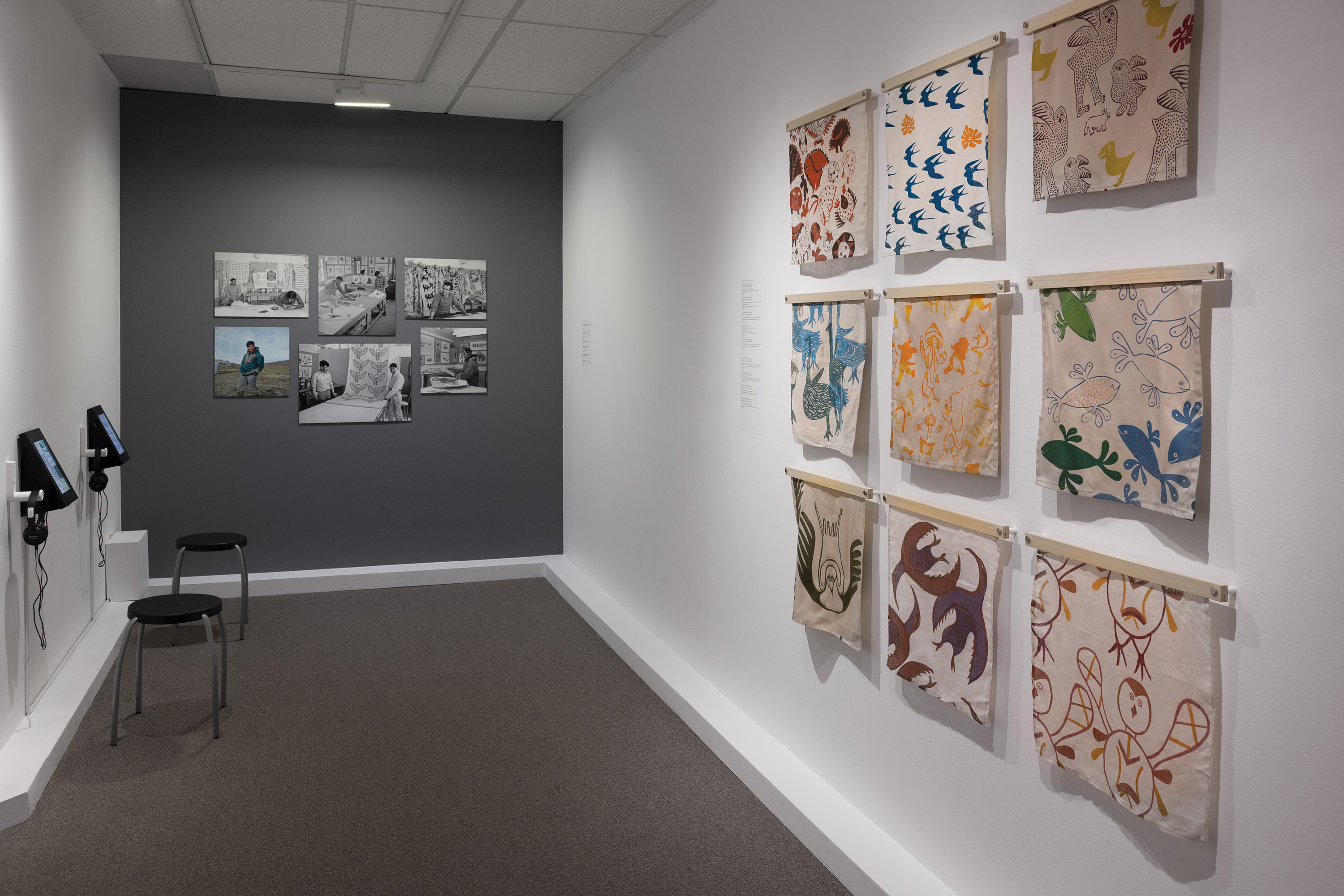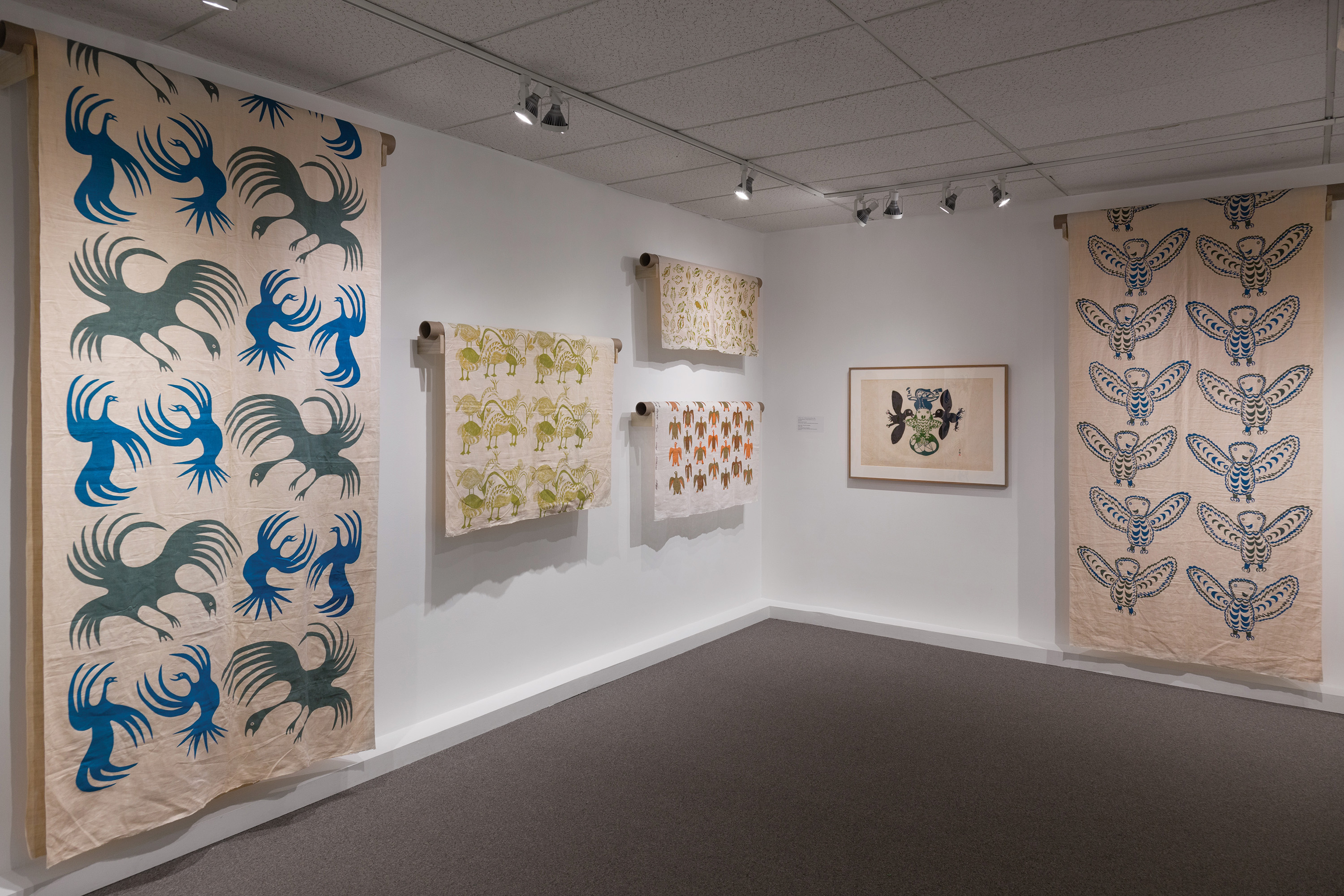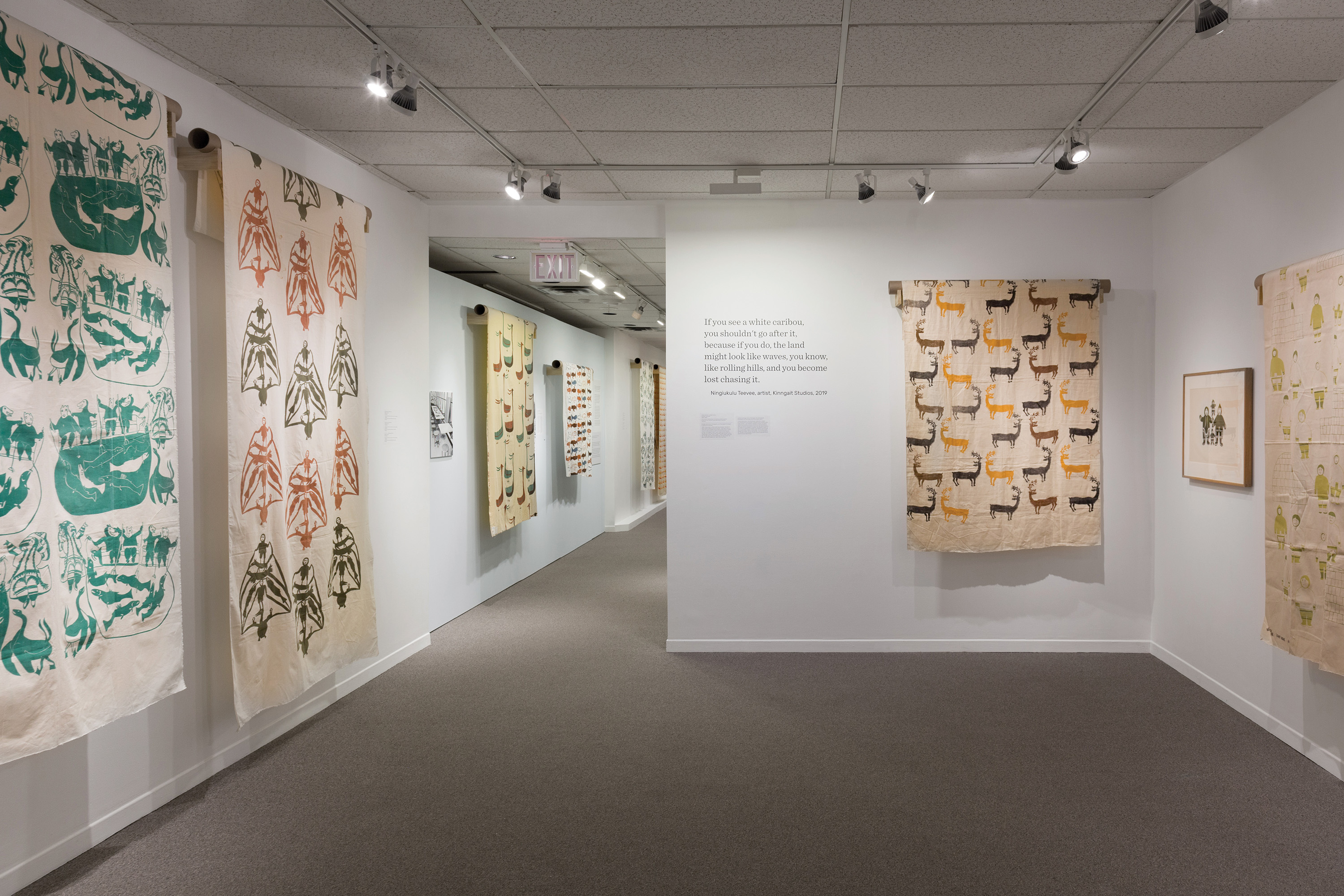Presenting the winner of the 2021 Governor General’s History Award for Excellence in Museums: History Alive!
|
A message from award sponsor |
|
|---|---|
 |
|
|
Ecclesiastical Insurance’s sponsorship of the Governor General’s History Award for Excellence in Museums: History Alive!, is a manifestation of our commitment and support for protecting and promoting cultural heritage in Canada. Congratulations to everyone involved in the Textile Museum of Canada’s Printed Textiles from Kinngait Studios for this well-deserved success. |
|
| Presented in partnership | |
 |
 |
History Unfolded
Kimberly Moynahan
The Textile Museum of Canada’s Printed Textiles from Kinngait Studios is a one-of-a-kind exhibition of screen-printed textiles produced by Inuit artists and printmakers in Kinngait (formerly Cape Dorset), Nunavut in the 1950s and ‘60s. It is the only known public collection of Inuit printed textiles in Canada. The exhibition traces the evolution and impact of the textiles and explores their legacy through the work of contemporary Inuit fashion designers.
Printed Textiles from Kinngait Studios is the culmination of an ongoing partnership between the Textile Museum and the West Baffin Eskimo Cooperative (WBEC), an Inuit art making co-op that operates Kinngait Studios, the oldest fine arts print studio in Canada. This unique collection of long-forgotten work first came to light in 2016 when William Huffman, marketing manager at Dorset Fine Arts in Toronto, came across a box in a storage unit. In the exhibit’s virtual tour, he recalled the moment—
“…I was digging around our storage unit and this magical box falls to the ground and textiles come out and immediately I realized how important this was, [and] called the Textile Museum…”

This exhibition explores the lives and work of a group of Inuit artists and printmakers in the 1950s and ‘60s. Printed Textiles from Kinngait Studios installation image at the Textile Museum of Canada. Photo — Darren Rigo
Dorset Fine Arts is the marketing arm of WBEC. The fabric had been stored in Kinngait since screen-printing stopped in 1968, and then at some point it was shipped to Dorset Fine Arts for safekeeping. Huffman invited the Textile Museum’s curatorial director Sarah Quinton, senior curator and manager of collection Roxane Shaughnessy, and former staff member Anna Richard to come examine the fabric. There they saw dozens of printed textiles featuring bold colourful patterns by well-known Kinngait artists. “It’s hard to describe how remarkable it was,” Shaughnessy said.
In 2017, the Textile Museum and WBEC formed a partnership and began envisioning an exhibition. The museum would be the steward for the collection and would ensure broad public access to the 194 textiles in the WBEC collection. These were transferred to the museum on a long-term loan. There, the work of cataloguing and photographing the collection, identifying artists and printers, and establishing provenance of the textiles would begin. While some of the designs had been registered in the Canadian Industrial Designs Database, most were not, suggesting they were experimental pieces that were never put into production. Part of the research would be to understand the context of this experimental period of printmaking.
Working with The Inuit Art Foundation, which facilitated connections, the museum contacted everyone who might know about the textiles and the history of screen-printing in Kinngait—artists, scholars, museum professionals, and historians. They put together a curatorial and research team that included Inuit and non-Inuit specialists. Inuit scholar and art historian Dr. Heather Igloliorte was brought in to serve as project advisor.
While the history of paper printing in Kinngait was well documented, there was almost no information on the fabric printing enterprise. Hence, researcher Anna Richard, Shaughnessy and others dug into Library and Archives Canada’s image collection, newspaper and magazine archives, reports, academic journals, oral history transcripts, and anything else that might hold clues to the textiles’ origins.
Slowly, the story of the fabrics began to unfold. They had been created during a brief yet pivotal time in Kinngait printmaking. The 1950s and ‘60s were a period of social change and artistic experimentation. Inuit communities were facing significant traumatic pressures that threatened their language, lifestyle, and relationship to the land. At the same time, mid-century design was growing in popularity, and the North American and European demand for artist-designed fabrics was high.

Snowy Owl textile (right) by ᐱᑦᓯᐅᓛᖅ ᐊᓲᓇ / Pitseolak Ashoona (1904 - 1983). Printed Textiles from Kinngait Studios installation image at the Textile Museum of Canada. Photo — Darren Rigo.
Printmaking had first been introduced to Kinngait as part of a 1950s government program to encourage handicraft production. WBEC was established in 1959, and Kinngait artists quickly became internationally known for their block-printed paper designs. However, block printing on fabric was unfeasible, so the studio turned its attention to silkscreen. Thus began several years of experimentation, as printmakers developed workable techniques to produce the textiles. It was these experimental pieces that turned up in the box discovered in Toronto 60 years later.
“The fabrics in Cape Dorset were kind of scraps left over in the studios, some that didn’t really work out, like a studio proofing. They weren’t meant to be sold, so they were just boxed away… we didn’t want to throw them away.” — Elder Jimmy Manning (Printed Textiles from Kinngait Studios catalogue)
Once screen-printing was mastered, WBEC expanded into a commercial fabric printing enterprise. The textiles produced went out into the world and became household items like curtains, tablecloths, and pillow covers. Some designs won international awards and even appeared at Expo ‘67. By creating and marketing screen-printed textiles, Inuit artists were able to capitalize on the mid-century design craze and take part in the global economy.
More importantly, the art itself became a way for Inuit people to record and preserve stories, legends, and traditions. The plants, animals and other images on the textiles were more than just pictures on cloth. As Dr. Heather Igloliorte wrote in a 2017 article in Art Journal—
“By embedding that otherwise forbidden knowledge in their artworks, Inuit artists expressed the principle of qanuqtuurungnarniq, being innovative and resourceful to solve problems, by using the means available to them — art making — to cleverly safeguard Inuit knowledge for future generations.”
Shaughnessy travelled to Kinngait in 2018 to share what the museum had learned about the textiles with the Kinngait community, and to interview elders who might be familiar with the mid-century screen-printing initiative. She made a presentation to printmakers and artists at the studio that included images of some of the textiles. It was an emotional moment, as attendees saw works made by friends and loved ones now deceased. Two printmakers recognized works of their own relatives.
Shaughnessy returned to Kinngait a year later, along with curatorial project coordinator Alexandria Holm, to conduct interviews with contemporary artists. They also held a public presentation at the local high school. The turnout was high and community members enthusiastically shared their memories and stories, some recognizing patterns they had seen in photos or the homes of older relatives.

Barren Ground Caribou textile (back wall) by unidentified artist. Printed Textiles from Kinngait Studios installation image at the Textile Museum of Canada. Photo — Darren Rigo.
Finally, to connect these historic printed fabrics to contemporary Inuit life, the museum invited three contemporary Inuit fashion designers to share their thoughts on the 60-year-old Kinngait fabrics. Martha Kyak of InukChic reflected on the artwork in the Printed Textiles from Kinngait Studios catalogue —
“You see their connection to the land and the spirit world, because they believed that everything had a soul, and the animals would change to humans, as told in the legends and the stories... so when you see these images, that’s what I think of — how they were thinking.”
The Printed Textiles from Kinngait Studios exhibition ran from December 2019 through January 2022. Video and audio tours of the exhibit remain on the museum website. As part of the museum’s mandate to make the textiles available to the public, the full collection is being digitized and will be made available online. The exhibition will go on tour beginning this year. While the schedule is not yet finalized, plans for the tour include Alberta, Manitoba, and, of course, Kinngait. M
The Textile Museum of Canada is the winner of the Governor General’s History Award for Excellence in Museums: History Alive! which will be presented at a ceremony hosted by the Governor General later this year.
Kimberly Moynahan is a freelance writer who has written exhibits for children’s museums, science and cultural centres, and heritage museums across Canada and internationally. Her articles and essays have appeared in Muse, EarthLines Magazine, Zoomorphic, Labrador Life, Hakai Magazine, and Scientific American’s Best Science Writing Online. She and her husband live in a net-zero home tucked in among the pines on a rugged lakeshore near Kingston, ON. It is located on the traditional homelands of the Anishinaabek and Huron-Wendat Peoples.
